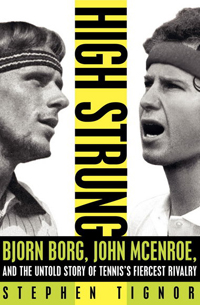Mr. Nasty: Part 3
Steve Tignor

Ilie Nastase lacked the drive to win that powered Borg, Connors, and all other great tennis champions. He could be bored by straight forward success, and he often courted failure.
But his performances were unique. For better or worse, they obliterated whatever restraints remained in tennis from its amateur days and brought the game up to date with the culture at large. Nastase found the outer limits of what tennis fans and players could handle, and he has no descendants or imitators in the more rigidly professionalized tennis world of today.
As with any child, plenty of Nastase was puerile: moonings and middle fingers were a given. Plenty was offensive: he once called Arthur Ashe a "bloody nigger" on national TV, and referred to the doubles team of Harold Solomon and Eddie Dibbs as 'Jew boys." (Nastase was later surprised to learn that Dibbs was Lebanese.)
But he was an equal-opportunity offender. When he spotted a South African, he would greet him with a cheery, "Hi racist." There was also plenty about Nastase the person that, like his play, was creative and original and even touching. No account of him would be complete without at least a partial list of his more memorable antics.
At a tournament in Louisville in 1975, it was required that doubles teams wear matching clothes. Nastase, who was playing with Ashe, showed up for one of their matches in blackface.
In the late '70s, Nastase played Borg in a meaningless indoor event. Nastase was on the way down. Borg was at his invincible peak.
The Swede won the first set handily, but Nastase began to come back in the second set. After each point that he won, he would stop, stand perfectly still, and stare questioningly at Borg's coach, Lennart Bergelin, as if to ask, "What happened to your Mr. Perfect .on that one?" Even the Ice Borg eventually cracked up.

In Stockholm in 1975,Nastase was agitated by a fan and began to yell at him. His opponent, once again his eternal straight man Ashe, grew annoyed. When Nastase finally tried to serve, Ashe held up his hand and said he wasn't ready.
Nastase began his service motion again, but stopped halfway through and asked, in a teasing voice, "Are you ready, Mr. Ashe?" Then he did it again. And again. And again. Over and over he stopped and asked, "Are you ready, Mr. Ashe?"
Finally Ashe snapped, walked off the court waving his arms, and later went berserk in the locker room. The next day, Nastase walked up to where Ashe was sitting in the hotel dining room with a bouquet of flowers. He was forgiven.
At the French Open in the early 1980s, Nastase and Ion Tiriac were playing the Italian doubles team of Adriano Panatta and Paolo Bertolucci. Nastase ·knew that Panatta, even more than Borg, was ruled by superstition. (One night he had been driving to a party with Panatta when a black cat .crossed in front o fthe Italian's car. Panatta immediately turned the car around and went home.)

Before the doubles in Paris, Nastase told Tiriac, "I think we can make it easier." Tiriac, immediately suspicious, narrowed his eyes and said, "What do you mean? What the hell are you planning?" Nastase hired a tournament employee named Mabroukto find him a black cat.
After roaming the neighborhood, Mabrouk came back with a gray cat. Nastase threatened to spray him black, so Mabrouk went out and found a real black cat.
Nastase carried the cat, wriggling in his racquet bag, onto the court and let him out as the two teams were flipping a coin to see who would serve first. The cat tore straight at the Italians. Panatta jumped backward and shouted at Nastase, "You idiot, you idiot, you're such a shit!" Nastase and Tiriac won easily.
As Mel Purcell knew, Nastase had a special history with the U.S. Open. He met his first wife, Dominique, when he glimpsed her in the stands at Forest Hills in 1971.

The following year, Ashe (who else?), who had just lost the final to Nastase, took a moment during the trophy ceremony to reprimand his opponent for his behavior. Nastase, in a move symbolic of the new pro era, answered Ashe by picking up his winner's check and waving it in his face.
In 1976, Nastase played Germany's Hans Pohman in the second round at Forest Hills before a full and very rowdy house. At one point, Pohman, suffering from cramps, took a theatrical dive to the court.
Nastase thought he was faking it (he also thought the guy was stealing his thunder). He blew up at the umpire and spat at Pohman, thereby incurring the unbridled wrath of the audience.
When Nastase won, both Pohman and the umpire refused to shake his hand. On the walk back to the locker room, hundreds of fans, including the mildest-looking senior citizens, waited to curse Nastase as he walked past.
Once there, Nastase tried to bury the hatchet with his opponent, but when he put out his hand, Pohman haughtily refused to shake it. Nastase drew back and said the only thing that he could possibly say to a German at that moment: "Fuck you, Hitler!"
Three years later, at Flushing Meadows, Nastase managed to one-up the Pohman match with his evening encounter with McEnroe, a night that the American called "the circus to end all circuses."

In a night match that had been promoted like a heavyweight fight, Nastase, bent on stirring up trouble, went into his customary stalling act and was defaulted by umpire Frank Hammond. But tournament director Bill Talbert, fearing a full scale riot from the pro-Nasty crowd of 10,000, chose to remove Hammond instead of defaulting Nastase.
Ten years of Open tennis had led to a complete reversal of authority: the pros, not the game's officials, were now in charge.
At one stage during the breakdown, Nastase heard McEnroe call him a "son of a bitch." Nastase told the referee, "You make him call me Mr. Son of Bitch."
Afterward, though, it was a different story. The performance was over. Just as he had surprised Connors and Pohman with his friendly gestures in the locker room, Nastase shocked McEnroe by asking him to.dinner. McEnroe accepted.

The match had, in a twisted way, been a passing of the torch, from one decade's high-strung bad boy tennis artist to the next decade's. Looking back, several writers saw it as an unfortunate early lesson for McEnroe-Nasty had shown him that the players could get away with anything now.
But another witness who was.in the locker room saw it differently. Worried about the New York night audience, Nastase had asked Doug Henderson, Jimmy Connors bodyguard, to sit in his box. ("Hey Chocolate," he'd said to the African American Henderson, "come watch me tonight, okay?")
Afterward, Henderson sat with the players and looked at McEnroe, whom he had known since prep school. "I could see that Mac was learning to handle any type of situation," Henderson says. "He was becoming a guy who could survive out there."
The following Sunday, McEnroe won his first U.S. Open. It didn't seem to bother Nasty. ''I'm glad he came around," Nastase said of McEnroe. "Now they can pick on him."

There was one other U.S. Open event involving Nastase that showed a different side of the man. In 1979 Renee Richards entered the tournament for the third time. At that time, the transsexual Richards was viewed as a freak by the men and with great suspicion by the women.
Nastase asked Richards to play mixed doubles with him. "Not surprisingly, I got teased the whole time by all the players," he said. "'Only you can play with that person, not man not woman," they said. But for me it was important to help a person who no one else was helping."
Nastase insisted they "make it fun." On the first point of their first match, as he put away an overhead, Richards slapped him on the shoulder, and he fell down as if she had hit him hard. The crowd laughed. The odd-couple team reached the semifinals that year and became a crowd-pleaser at two U.S. Opens.
But even while he was clowning with Richards, Nastase's personal life was coming apart. He rarely left the road. His wife and daughter couldn't go everywhere with him, but Nastase loved tennis and the camaraderie of the tour too much to leave it.
He also embodied a conundrum of the pro era and the sports mass market: the nastier he was, the more he was in demand. In World Team Tennis, he was even introduced with a name more befitting professional wrestling: The Temperamental Nastase.
"By the end of the 70s," he wrote in his autobiography, "Dominique knew that I was no saint when I was away. She didn't need to ask me questions, go through my pockets, or peel off the long blond hair from my jacket (most likely the white hair from the horses at Studio 54)." According to one player, Nastase's indiscretions had become more blatant as the years passed.

The Nasty era, which had been synonymous with the first Wild West decade of the Open era, was coming to an end as he faced Mel Purcell in Louis Armstrong Stadium. But it wasn't over quite yet.
The night crowd at Flushing inspired a little of his old dark magic, and he and Purcell battled through five sets. "He was acting like a jerk, as usual, yelling at everyone," Purcell says.'"But it was a hell of a match."
In the fifth set, both players were nervous and began to dink the ball back and forth, not wanting to miss. "It got ugly," Purcell says.
It was a style of play that had been a specialty of Nastase's in the old days, but it didn't work on this· night. To the disgust of the well-lubricated audience, the Kentucky boy won the fifth set 6-3.
Nastase breezed past him afterward with the barest of handshakes. "He was pretty pissed," Purcell says.
Two years earlier it had been widely noted that Ilie Nastase was the only player at the U.S. Open.to have his face on the front page of the New York Post. The accompanying story was about his starting a riot against McEnroe rather than playing tennis.

The consensus, even among the sport's more traditionalist commentators, was that this was the kind of exposure that tennis needed if it was going to continue to grow and appeal to bigger audiences, if fit was going to take its place with baseball, football, and boxing.
"People want excitement," Richard Evans wrote in Tennis Week after the 1979 Open, "and if they can't find it at a tennis stadium they will go off and seek it in less savory places."
Now, two years later, a photo of Nastase again appeared in a New York paper. But it wasn't on the front page. Instead, a tiny shot at the back of the sports section captured the paunchy Romanian doubled over the net during his loss to Purcell.
He had tripped and fallen forward and nearly flipped over onto the other side of the court. For a player long known for his balletic grace around a tennis court, a player who liked to bound over the net even after defeats, it must have been a hard fall.





